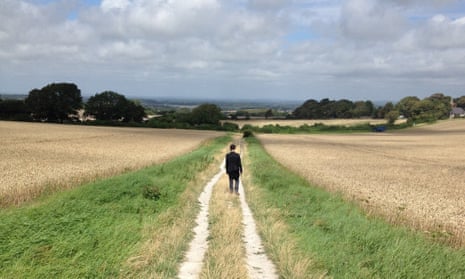Solitude is not the same as loneliness. Lonely people feel the need for company, while solitary types seek to escape it. The neatest definition of loneliness, David Vincent writes in his superb new study, is “failed solitude”. Another difference between the two groups is that hermits, anglers, Trappist monks and Romantic poets choose to be alone, whereas nobody chooses to feel abandoned and bereft. Calling yourself “self-partnering”, meaning that you sit in the cinema (should they be open) holding your own hand, may be either a genuine desire for solitude or a way of rationalising the stigma of isolation. The greatest difference of all, however, is that solitude has rarely killed anyone, whereas loneliness can drive you to the grave. As the coronavirus rampages, some of us might now face a choice between physical infection and mental breakdown.
For the 18th-century Enlightenment, being on your own was a deviation from the true nature of humanity, which was sociable to its core. It was with the Romantics that this began to change. Isolation was now what we shared in common. Frankenstein’s monster is one of the first great loners of English literature, spurned and vilified by humanity. Yet though loneliness was a symptom of the modern era, solitude could be a critique of it. It was one of the few ways in which you could get in touch with the transcendent, thus revealing what was lacking in an increasingly materialistic society. When Wordsworth writes that he wandered lonely as a cloud, he may mean simply that he was by himself, or that he lacked companionship, or that being alone allowed him space for self-knowledge and spiritual meditation.
That the self is revealed only in retreat from the world is a belief which runs back at least to the early Christian desert fathers, but this book shows how the need for self-communion intensifies as modern societies become more crowded. Such withdrawal could come at a cost: Virginia Woolf insisted on the need for a room of one’s own, but only the upper middle classes could have afforded one at the time. In the 19th century, only 1% of the British population lived on their own; in 2011 it was 31%, or some 8 million people. Yet as urbanisation and large families pitched people together, the anonymous world of industrial capitalism also split them apart. Rural life may have been rough, but at least you knew who lived next door. So if a longing to be alone became more acute, so did a sense of being forsaken.

A History of Solitude calls for a “quiet history of British society”, or “a history of doing nothing at all”. It is a remarkably versatile study, ranging from the poetry of John Clare to the “networked solitude” of the internet and the cult of mindfulness. There is a fascinating section on solitary walking, which the 19th-century middle classes indulged in for spiritual recreation (Wordsworth is reckoned to have walked some 180,000 miles during his lifetime), and the labouring classes undertook in order to find work. Constant perambulation was what united peasant and patrician.
One can, of course, be solitary in company. In fact, the psychologist Donald Winnicott claims that a child can learn to be alone only in the presence of a trusted adult. The second half of the 19th century witnessed a rash of new convents, where women could be alone together, while a less high-minded form of solitary confinement was provided by the prison system. (The yachtsman Robin Knox-Johnson thought the crime rate might fall if people were sentenced to sail around the world alone instead of going to gaol.) A cameo on smoking shows how in the postwar era the habit was seen less as a route to the churchyard than as a pathway to inner calm, even as a variety of prayer.
Vincent has his doubts about the so-called epidemic of loneliness in modern life. He points out that more and more men and women after the second world war decided to live alone because it was feasible to do so. In any case, widespread loneliness isn’t new, and some sociologists see little evidence that it is on the increase. By contrast, Fay Bound Alberti’s A Biography of Loneliness approaches the issue with a deeper sense of urgency. If Vincent is a social historian, she is an emotional one, convinced that human feelings, far from being timeless and universal, are as historically conditioned as thought and action, and every bit as mutable. The case can be challenged: the way we express emotion is certainly shaped by our culture, but grieving over the loss of a loved one, or panicking when embraced by a grizzly bear, don’t seem to depend on whether you come from Kansas or Cambodia. It is equally doubtful that all emotional states are gendered, as this book maintains. Do women really react differently to men when falling off a mountain? “All emotions are political,” Alberti asserts, but “everything is political” statements risk emptying the term “political” of any useful meaning. It represents an overreaction to those who think that the post of lord chancellor isn’t political but natural.
Even so, this is a compassionate, wide-ranging study, which makes the bold claim that loneliness was invented around 1800. This may help to explain why Robinson Crusoe doesn’t once complain of lacking company. It also chimes with Vincent’s case: in his view, “lonely” becomes a negative emotion only around this time. It is now less a fact (“on one’s own”) than an existential condition, as with Byron’s gloomy heroes. Today, Alberti argues, lonely people are 30% more likely to die early than less lonely ones, the poor are lonelier than the well-off and the young are the loneliest of all. To be lonely is to cease “to exist in a meaningful way with other people”.

There’s a gripping account here of Queen Victoria’s pathological grief over Prince Albert’s death, which compares the stricken monarch with the surreal Miss Havisham of Dickens’s Great Expectations. The book is impressively balanced: it sees that loneliness, in the sense of Vincent’s “solitude”, can be the price one pays for creativity. Loneliness can be restorative as well as destructive, but only when it is a choice. Historically speaking, it springs from the separation of self and society; but this long pre-dates 1800, as Hamlet or Othello might testify. Overlooking this fact, the book idealises the 18th century as a “relatively collective world”, which would have come as something of a surprise to the vagrants and workless who wandered its highways.
All the same, Alberti is right to politicise loneliness, unlike the neuroscientists who are racing to develop a pill to cure it. One can’t dissociate feeling useless and disconnected from the history of possessive individualism, even if that history stretches further back than the author imagines. If, as she points out, “there are very few physical spaces where people can meet in the 21st century without paying for the privilege of being there”, it is largely because the gospel of neoliberalism can see no point in them. There is, then, a villain in this book, as there isn’t in the more cautious reflections of Vincent. But there is also a good deal more: a brief history of old age, speculations on homelessness, refugees, soul mates, hunger artists and Fomo, the connections between loneliness and obesity, a digression on Wuthering Heights which fails to drive home what an utter bastard Heathcliff is, and an array of other topics.
What distinguishes both these studies is their mixture of empirical research and general commentary. Both recount a grand narrative about solitude or loneliness, unfolding across the centuries, but they do so on the basis of detailed documentation. In their combination of scholarship and sympathy, poetry and clinical psychology, they appeal as much to the common reader as to the expert. One answer to loneliness is solitude. Enjoying being on one’s own, or at least being able to tolerate it, is part of being grown up. But Vincent and Alberti both highlight the privilege this involves – how positive aloneness is possible for the middle-class poet, but not for the impoverished housewife with children to care for, not least in a society which has hacked social provision to the bone.
